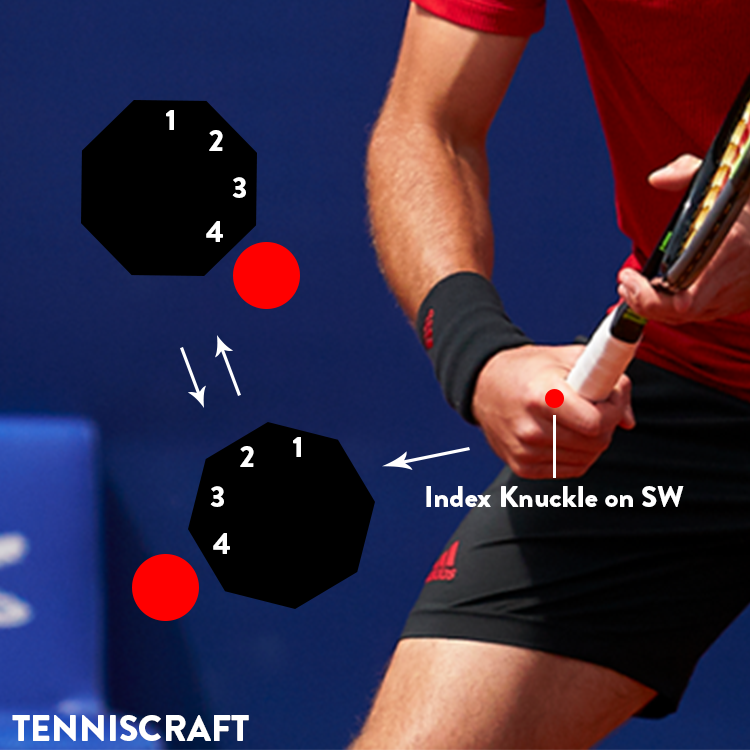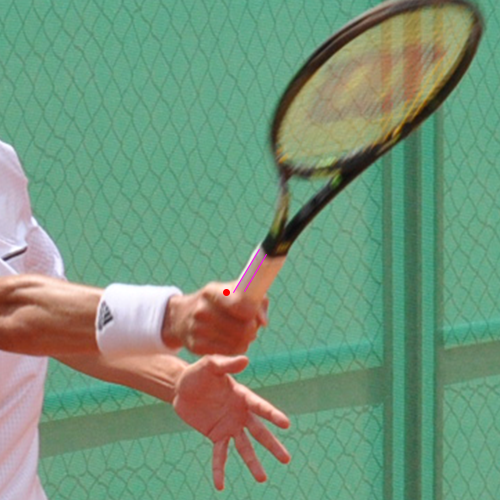Tsitsipas' Forehand Grip, Illustrated
Spoiler: It’s not an Eastern Grip.
Stefanos Tsitsipas
SEMI-WESTERN
Index Knuckle on Semi-Western (Bevel 4), bordering Eastern (Bevel 3)
Heel Pad on Semi-Western (Bevel 4)
TLDR:
There’s a strong, prevailing opinion that Stefanos Tsitsipas has an eastern grip. Even his father has spoken on record that this is the case.
While he certainly swings like an “eastern”, a minority of people have noted that his grip looks far closer to a semi-western grip.
What started out as a simple guide, evolved more into an investigative piece. I’ve assembled a wide range of photos and after work with a ton of close-ups, my conclusion is that Stefanos’ grip should most definitely be classified as a semi-western.
Side note: Why would Apostolos Tsitsipas be wrong?
His index knuckle borders very closely to eastern, but is still distinctively semi-western.
Federer is an excellent point of comparison, as it widely accepted that he plays with an eastern grip that is very close to semi-western. When we compare them side to side, it’s far more obvious that Roger’s forehand grip is on the eastern bevel, while Stefanos is on the semi-western.
To be a little bit more specific, Federer’s index knuckle is on eastern and borders semi-western, whereas Tsitsipas’ is on semi-western, but borders closely to eastern.
Stefanos Tsitsipas, Vienna 2021: Despite swinging like an “eastern grip”, close ups to Tsitsipas’ index knuckle show that he is on Bevel 4, the semi-western grip.
Roger Federer, AO 2020: You can see how Roger’s index knuckle is on the very edge of bevel 3, right before the semi-western grip. This is the typical forehand grip that Roger will employ for most situations. Image Credit: Rob Keating
Ready Position, Barcelona 2021: Tsitsipas is one of the many pros that waits on his Forehand grip while in ready position. This gives us the most accurate and focused shot of his index knuckle. From this angle, it is very clearly a semi-western grip. Image Source: Barcelona Open
FH Follow-Through, Citi Open 2018: The follow through gives us the best glimpse of where the heel pad is. The diagrams are reoriented to make it easier to visualize. The pinky knuckle is usually not referenced, but it’s purpose will be explained in the analysis section. Image Source: JC, Wiki Commons
Introduction
I’ve worked on a good amount of grip guides (including all of the Big 3) and Tsitsipas is one of the more interesting cases that I’ve worked on. At first, I was expecting this to be a quick article, but after doing some research, I’ve come to the realization how divisive and sometimes controversial this topic would be. Just look at this TW thread — it gets quite juicy half-way through. Poster Sysyphus makes an argument for the SW grip, but it quickly devolves into torches and pitchforks. There are a couple of other TW threads that seem to argue for the SW grip with evidence backing their claims, but overall, this seems to be the minority opinion. Because this topic seems so divided, I felt there was a need to spend a little bit more time on this article.
This situation feels very similar to when Rafa first came in the limelight decades ago, and everyone believed he used a western grip. I can only conclude that while swing path and technique can often hint to a grip, identifying the index knuckle and heel pad location is the only 100% method of determining grip.
ANALYSIS
Ready Position
Usually, the best photo to identify the FH grip is to look for a backside forehand where the camera exposes the index knuckle from behind the player.
From a photographer stand-point, however, this is obviously not ideal. It doesn’t show the face of the player, and it’s just odd to take the behind of a player for your editor. That’s why it’s so rare to find high resolution photos that highlight the index knuckle mid-forehand. Thankfully, many modern players, including Stefanos, typically hold their FH grip in ready position. This will be our best opportunity to identify his grip.
For a player that favors his forehand side, he’s going to be waiting on that exact grip, and in this picture, it’s crystal clear that his index knuckle is on the semi-western bevel. This photo is, in my opinion, the most definitive evidence for the SW grip for Stefanos.
As a quick FYI, players typically either wait on the FH grip, or on continental. Continental is less common these days, and Federer is one of the few.
Follow Through
For the follow-through it can be a headache to reorient the bevels, but I’ve included a handy illustration to help identify them. Typically when talking about grips, we usually reference only the heel pad and base index knuckle. There is a reason why I’ve included the base pinky knuckle for this analysis. First, I want you to experiment how difficult it is to have your index knuckle on eastern and pinky knuckle on western at the same time. It’s not entirely impossible, especially since Stefanos does have massive hands. But the more you move your index knuckle to a strong eastern and closer to bevel 2 , the more it becomes impossible to have the pinky knuckle on western at the same time.
The general rule of thumb, or pinky I suppose, is that you’ll typically see it on the 5th bevel only with semi-western or western grips. I should point out this is not an infallible rule by any means. There is sometimes a great deal of movement of the grip on the follow-through, and the combination of hand variation and grip size can be significant enough. Nonetheless, this rules out any kind of eastern grip that is too far from the SW bevel. I’ve heard outrageous claims of a continental-eastern grip for Stefanos and we can just toss that in the garbage. In the grand scheme of things, this point doesn’t completely rule out eastern, but just another tally that suggests its not the case.
As a small note, due to the way the bevels and hand interact, the heel pad is commonly lower than the index knuckle in position. Just because Stefanos’ heel pad is on semi-western does not mean that his grip is semi-western. Federer is an example of a player that has his index knuckle on eastern, but his heel pad on semi-western. This is overall still classified as an eastern grip. In short, the index knuckle identifies the grip and the heel pad gives the alignment of the hand.
Time to Squint
Unfortunately, from here the quality of the reference photos drops. Stefanos has been around for a lot less in comparison to the Big 3. This decades of difference simply means there are just fewer high resolution photos available. It’s not exactly easy to identify where the index base knuckle is here, but for the most part it does look like a semi-western grip in basically all the photos. In one photo, I would definitely consider it as an eastern grip and I’ve included it in the pictures below to be comprehensive. That being said, I think that the majority of photos pointing to SW and one photo being Eastern, overall points to the conclusion that he is a SW grip bordering Eastern.
ASB Classic 2017: OutlineSource: Fiona Goodall/Getty Images AsiaPac.
USO 2020: It’s close but this would be the one photograph that looks like Stefanos is on the eastern bevel. Image Source: Darren Carroll/USTA
Image Source: Ojo Rojo on TW Forum
Sydney International 2019: I felt adding guidelines here made the picture harder to see. In my opinion, for this photo it’s easier to just see the grip as is. Image Source: Rob Keating, Wiki Commons
Federer Comparisons
Federer’s forehand grip is an excellent reference for this topic because his grip is widely accepted as an eastern grip that is closely bordering SW. The first claim that we can debunk is that Stefanos uses a conservative eastern grip (middle of bevel 3 or bordering continental). His grip is close enough to Federer that it warrants a close comparison.
These two pictures are perfect for analysis because they are both shot from similar perspectives. You might have to squint a little, but Federer’s index knuckle is most definitely higher on the bevels relative to Stefanos’.
If we take a look at the follow through it follows the same idea. Once again the pinky knuckle is quite handy. Federer’s pinky knuckle is around the SW bevel while Tsitsipas is most definitely at the western bevel. So if the end of Stefanos’ hand is farther down the bevels than Roger, it stands to reason that his index knuckle (which determines grip) is also further down. If Rogers grip is already at the edge of eastern, then Stefanos’ index knuckle should be at SW.
“Generally when you have a classic Eastern forehand grip like Stefanos...You don’t have to think so much how to prepare, you just swing. It’s a natural swing. When you let your arm swing naturally, it creates beautiful mechanics”
Father Condundrum
Apostolos is not only Stefanos’ father, but his personal coach since he started playing tennis. So it raises a question of why would he be wrong in the first place?
The first notion to dispel is the fact that coaches are infallible. Apostolos is most definitely a very accomplished coach, who had a large hand in bringing two of his sons into the world of professional tennis. But it’s a simple matter of fact that grip considerations are such a small, trivial matter that it’s not too implausible for Apostolos to be mistaken here.
After all, as a coach myself, there is very little time spent on grips once you pass a certain level—and Stefanos has long past the point where you need to double-check grips with him. You have to consider that there are just simply far more important matters to address when you are coaching Stefanos Tsitsipas… and grips are not even a distant concern.
What’s most likely the case is that Stefanos started out as an eastern forehand, perhaps personally taught from his father. Than as the years progressed, it slowly transitioned into a semi-western. After all, at age 16, Stefanos was splitting time with his father and the Mouratoglou Academy. So there would be stretches of time where Stefanos was away from his father, working and adjusting his forehand with the Academy.

















